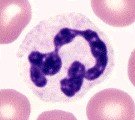|
Segmented Neutrophil
Neutrophils are produced in bone marrow, released into
blood after completing their maturation in marrow, circulate for less than a

Canine segmenter
|
day, and migrate out of the vessels into tissues or into alveoli and gut
lumen. While circulating, neutrophils are distributed between large vessels
(neutrophils here form the circulating neutrophil pool or CNP; these are the
neutrophils in the usual blood sample) and small vessels (neutrophils here
form the marginating neutrophil pool or MNP). The total body neutrophil pool
or TNP comprises the CNP, MNP, and the pool of post-mitotic neutrophils in
marrow.
Humoral factors produced at sites of inflammation (e.g. G-CSF, IL-1)
stimulate increased production of neutrophils in marrow and increased
release of neutrophils from marrow. Chemotactic factors produced at
sites of inflammation (e.g. IL-8, complement components) direct migration
of neutrophils from blood vessels into the tissue at those sites.
Normally, neutrophils are released from marrow in an age-dependent manner,
i.e., the most mature cells are released before less mature cells.
Corticosteroids tend to cause movement of neutrophils from the MNP to the CNP
and release of some cells from the marrow pool, thereby raising the neutrophil
count in a blood sample. Endotoxin tends to cause sequestration of
neutrophils in the spleen, liver, and lung, thereby lowering the neutrophil
count in a blood sample; endotoxin also stimulates release of neutrophils from
marrow and increases granulocytopoiesis resulting in a rebound rise in
neutrophil count with presence of immature neutrophils (bands,
metamyelocytes).
Last Updated: June 2000
|